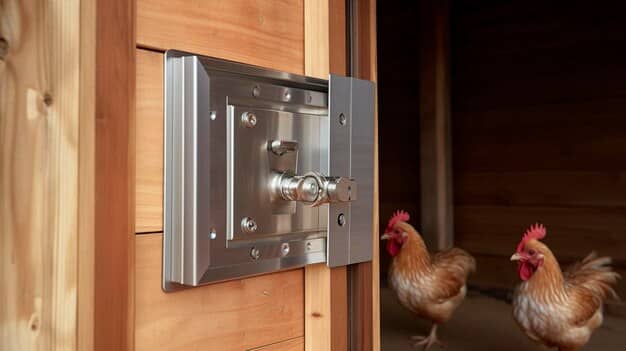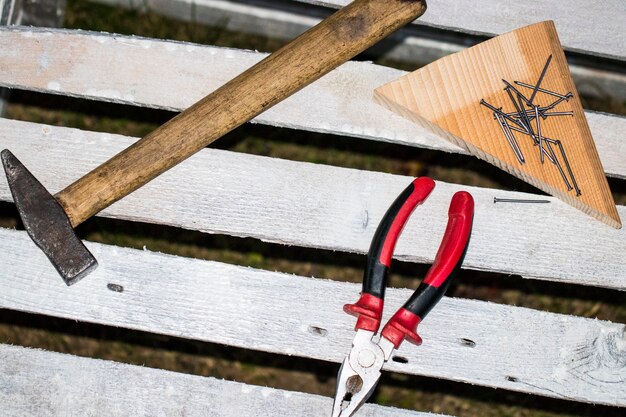Build a Chicken Coop: Predator-Proof DIY for Under $300

Building a chicken coop for under $300 is achievable with careful planning, resourceful material sourcing, and a focus on predator-proofing to ensure the safety and well-being of your flock.
Embark on a rewarding DIY project and build a chicken coop: design and construct a predator-proof chicken coop for under $300. Save money while creating a safe and comfortable home for your chickens.
Why Build Your Own Chicken Coop?
Building your own chicken coop offers numerous benefits over purchasing a pre-built one. It allows for customization according to your specific needs and available space.
Additionally, constructing a coop yourself can be significantly more cost-effective, especially when aiming for a predator-proof design on a budget.
Cost Savings
Purchasing a pre-made chicken coop can be surprisingly expensive. By building your own, you control the materials and labor costs.
Customization
A DIY coop allows you to tailor the size, layout, and features to suit your flock’s size and your backyard’s unique characteristics.

Here are some typical materials you can use:
- Reclaimed wood and pallets: Offer a sustainable and affordable building option.
- Wire mesh: Essential for creating a secure enclosure against predators.
- Hardware cloth: A stronger alternative to chicken wire, providing added protection.
In conclusion, building your own chicken coop not only allows for significant cost savings and customization but also provides a unique opportunity to create a safe and comfortable environment tailored to your specific needs and preferences.
Planning Your Chicken Coop Design
Careful planning is crucial before you start building. Consider the size of your flock and the available space in your backyard.
Think about the coop’s location, access to sunlight, drainage, and protection from the elements.
Coop Size and Layout
A general rule of thumb is to provide at least 4 square feet of space per chicken inside the coop and 8-10 square feet in the outdoor run.
Location Considerations
Choose a location that offers partial shade, good drainage, and protection from strong winds. Also, ensure easy access for cleaning and egg collection.
Key considerations for the coop include:
- Sunlight exposure: Ensuring adequate sunlight for warmth and vitamin D production.
- Drainage: Preventing water accumulation to reduce the risk of diseases.
- Proximity to your house: Balancing convenience with odor control.
Effective planning is foundational to a successful chicken coop build. By addressing layout, location, and future expansion needs, you set the stage for a durable, functional, and budget-conscious coop.
Sourcing Affordable Materials Under $300
The key to building a chicken coop for under $300 is to be resourceful with your materials. Explore free or low-cost options before buying new.
Consider reclaimed wood, pallets, and discounted hardware.
Reclaimed Wood and Pallets
Look for free pallets or reclaimed wood from construction sites, online marketplaces, or local businesses.
Discounted Hardware
Check for sales, clearance items, or discounted hardware at local hardware stores.

Alternative resources include:
- Local classifieds and online marketplaces: Opportunities to find discounted materials.
- Habitat for Humanity ReStore: A great place to find salvaged building supplies.
- Construction site dumpsters (with permission): Sometimes contain usable lumber.
In essence, sourcing materials affordably involves a blend of creativity, diligent searching, and a willingness to repurpose. By embracing these strategies, the goal of constructing a chicken coop for under $300 becomes highly attainable.
Building the Coop: Step-by-Step Instructions
With your plan in place and materials sourced, it’s time to start building. Follow these general steps to construct your DIY chicken coop.
Remember to adjust the measurements and design to fit your specific requirements.
Framing the Structure
Build a sturdy frame using your reclaimed wood or lumber. Ensure it’s square and level for a stable foundation.
Creating the Enclosure
Attach wire mesh or hardware cloth to the frame to create a secure enclosure. Bury the bottom edge to prevent predators from digging under.
Here are some of the steps involved:
- Cutting the wood: Precise cuts for structural integrity.
- Assembling the frame: Using screws or nails for a secure connection.
- Attaching the wire mesh: Ensuring a tight and secure barrier against predators.
By following these step-by-step instructions, builders can efficiently and effectively construct a custom chicken coop tailored to their specific needs and budget.
Predator-Proofing Your Chicken Coop
Protecting your chickens from predators is paramount. Implement several measures to keep them safe.
Reinforce the coop with strong wire mesh, secure latches, and consider adding an apron of wire mesh around the perimeter.
Reinforcing the Structure
Use heavy-duty hardware cloth instead of chicken wire, especially for the bottom portion of the coop.
Secure Latches and Doors
Install latches that are difficult for predators like raccoons or foxes to open.
You should also consider:
- burying wire mesh: Prevents digging predators from entering.
- Covering the top of the run: Protects against aerial predators.
- Installing motion-activated lights: Deters nocturnal predators.
Effectively predator-proofing a chicken coop requires a multi-faceted approach. By reinforcing the structure, securing access points, and implementing deterrent measures, chicken owners can significantly reduce the risk of predation, safeguarding their flocks with confidence.
Essential Features for a Happy Flock
Beyond the basic structure, include essential features that contribute to your chickens’ comfort and well-being.
Provide nesting boxes, roosting bars, and a dust bathing area.
Nesting Boxes
Provide one nesting box for every 3-4 hens. Line them with soft bedding material like straw or wood shavings.
Roosting Bars
Install roosting bars at least 2 feet off the ground, providing ample space for all your chickens to roost comfortably.
Consider adding these features for a comfortable chicken coop:
- Adequate ventilation: Preventing moisture buildup and promoting air circulation.
- Easy access for cleaning: Simplifying maintenance and hygiene.
- Weather protection: Shielding chickens from the elements.
Ultimately, creating a chicken coop that caters to these essential needs not only enhances the well-being of the flock but also contributes to their productivity and longevity. By integrating these features thoughtfully, chicken owners can foster a thriving and contented flock.
| Key Point | Brief Description |
|---|---|
| 💰 Cost Savings | DIY coop construction can save money over pre-built options. |
| 📏 Customization | Tailor coop size and features to fit your flock and backyard. |
| 🛡️ Predator-Proofing | Use strong wire mesh, secure latches, and bury mesh to deter predators. |
| 🪺 Essential Features | Include nesting boxes, roosting bars, and dust bathing areas. |
Frequently Asked Questions
▼
Provide at least 4 square feet per chicken inside the coop and 8-10 square feet in the run. This allows for comfortable movement and reduces stress.
▼
Hardware cloth is preferred over chicken wire due to its durability. The smaller mesh size prevents predators from easily tearing through it, ensuring better protection.
▼
Bury wire mesh around the perimeter of the coop. An apron that extends outwards from the coop’s base can also deter predators like foxes from digging.
▼
Clean the coop weekly to remove droppings and replace bedding. A thorough cleaning should be done at least twice a year to prevent diseases and maintain hygiene.
▼
Check for disturbed bedding, damaged wire mesh, or missing chickens. Also, monitor for animal tracks or droppings around the coop and run to identify potential threats.
Conclusion
Building a chicken coop doesn’t have to break the bank. With careful planning, resourceful material sourcing, and a focus on predator-proofing, you can create a safe and comfortable home for your chickens for under $300. Enjoy the satisfaction of building something yourself and providing a healthy environment for your flock.





